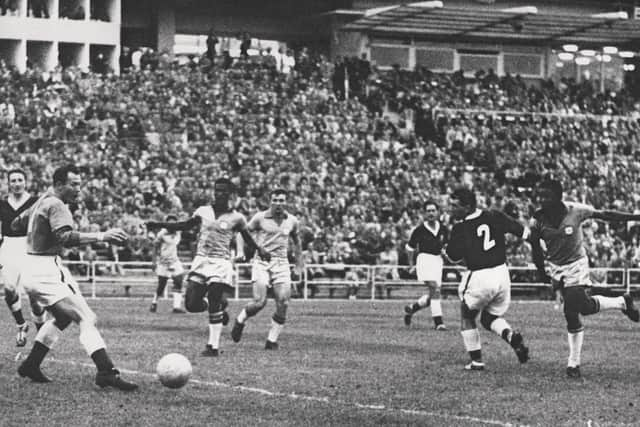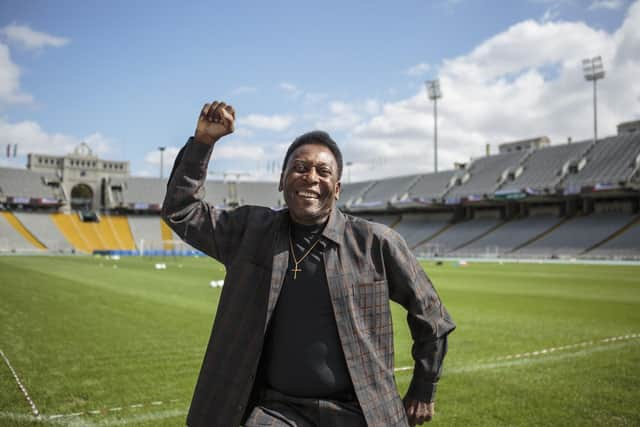Pele was a footballing genius who made the game beautiful with Brazil and set bar so high


The Brazil great was always willing to attempt the extraordinary and in doing so he redefined what was possible on the pitch.
Three moments from the 1970 World Cup finals in Mexico – widely regarded as Pele’s pinnacle – all ended with him being thwarted.
Advertisement
Hide AdAdvertisement
Hide AdThere was the incredible save from England’s Gordon Banks to keep out his bullet header, the audacious but missed attempt to beat Czechoslovakia’s goalkeeper from the halfway line in Brazil’s opening match and the outrageous dummy which bamboozled Uruguay’s keeper in the semi-final but ultimately did not result in a goal as Pele pulled the resulting shot wide.


But they only enhanced the overall impression of Pele as one of football’s pioneers, a man who ended his playing days with three World Cup titles to his name and over a thousand career goals, including 77 in 92 appearances for his country.
He died on Thursday, aged 82.
Edson Arantes do Nascimento, to give him his full name, hailed from the state of Minas Gerais – named after American inventor Thomas Edison.
He felt his footballing talent was a gift from God and also claimed he had been under special protection when it appeared he would drown while swimming in a river after bunking off school as a child, only to survive.


He fought for survival then, and even fought against the name which would later resonate around the world, which is said to have evolved from his love of his goalkeeping hero Bile.
“I fought in college with the kids because I said, ‘No, my name’s Edson’, but they called me Pele,” he said in 2009. “I got two days suspended because everybody in the school called me Pele. I hated it at that time. Today I love it because God gave it to me – a short name, easy to pronounce. In any language you can say Pele.”
When he arrived in Vila Belmiro to try out for Santos in June 1956, it was his father Dondinho who carried the star reputation. A tall striker famous for heading five goals in one match, he had retired early due to knee ligament damage, but not before teaching young Edson how to play, initially with a ball made from socks.
Countless goals in this street football environment inspired Santos to take a punt on the long-legged 15-year-old. Once he had scored on his senior debut he never looked back, plundering goals galore in the Sao Paulo state championship and flying straight into the Brazil squad for the 1958 World Cup after winning his first cap the year before.


Advertisement
Hide AdAdvertisement
Hide AdThe boy who had not long since left his humble village was jetting to Sweden, where he initially had to bide his time as a knee injury healed. Brazil unleashed the 17-year-old against Wales and France in the quarter and semi-finals – he scored the winner against Wales and a hat-trick against the French. That set up a final meeting with the hosts, where he scored twice more in a 5-2 win as Brazil won the World Cup for the first time.
A star was born – a star who inconveniently still had to fulfil a year of military service. Combining club and barracks duty, Pele sometimes played three games inside 48 hours, but nothing stopped the goals flowing. By the time of the 1962 World Cup finals in Chile he was no longer the unknown quantity of four years earlier, but instead the most sought-after talent in the world.
Santos flaunted their stellar team with extensive continental tours and, when asked why he never accepted an offer to play in Europe for the likes of determined suitors Inter Milan, Pele cited the amount of travelling involved. He preferred to win things – at club level at least – on South American soil.
Faith, once more, carried him on to the next chapter of his life. As his team-mates panicked when their plane hit a pocket of turbulence over the Andes en route to the finals in Chile, Pele remained calm and recalled saying: “I believe in God. If we are going to die, then so be it.”


It was not to be plain sailing in Chile, however. Brazil went on to win the tournament, but an injury suffered against Mexico meant Garrincha was their stand-out performer, while Pele brooded in the stands. That sense of frustration was amplified when Brazil flunked their second defence of the World Cup in England four years later. Pele felt the team had been poorly prepared. Too much time was spent obsessing over past glories while no investment was being made into devising a plan that would secure trophy number three. Two defeats and a solitary win, all at Everton’s Goodison Park, dumped Brazil out of the tournament.
A brief sabbatical from international duty – which encircled the fabled 1,000th goal, scored against Vasco da Gama – ended when Pele resolved to lead a revenge mission by returning for Mexico 1970. This time the now 29-year-old stayed fit throughout and, with a goal against Italy in the final, he would cap his finest display on the world stage as the star man in what is widely recognised as the greatest line-up ever assembled.
Earlier, following a thrilling 1-0 victory over England, he showed Bobby Moore the ultimate form of respect by exchanging shirts with the defender. Paying tribute to Moore after the Englishman’s death in 1993, Pele said: “He was one of the world’s finest defenders and a great sportsman. The shirt he wore against me in that 1970 match is my prize possession. The world has lost one of its great football players and a great gentleman.”
His debt to Brazil paid with the 1970 triumph, Pele looked to fix his own financial situation which had fallen into a parlous state due to a series of poor investments and his perceived entrapment by Santos. In an era long preceding the Bosman ruling, Pele was an early campaigner for footballers’ rights. He stalled over a multi-million dollar offer from New York Cosmos for several years, finally accepting the challenge in 1975 following advice from US Secretary of State Henry Kissinger, a football fan. Two years and 64 goals later he had helped double the North American Soccer League’s average attendance, laying the foundations for Major League Soccer, which continues to grow in popularity today.
Advertisement
Hide AdAdvertisement
Hide AdAfter football he moved into politics, leading campaigns against corruption, a sore subject which would later force him out of administrating the game, although no allegations were ever proven.
In his personal life, Pele married his first wife Rosemeri dos Reis Cholbi in 1966, with whom he had three children. He has a further two children from his marriage to his second wife, Assiria Lemos Seixas, a gospel singer, which began in 1994. He is said to have first met his current partner – Marcia Aoki – at a party in New York in the 1980s, but they only began to date after meeting again by chance in a Sao Paulo lift in 2010, two years after his second marriage had been dissolved. He and Marcia married in 2016.
Pele’s health battles began back in 1977 when he reportedly had his right kidney removed. He underwent a successful hip replacement operation in 2017, but was in a wheelchair at the 2018 World Cup draw in Moscow. The still-loved star had kidney stones removed in 2019, before having a tumour removed from his colon in September 2021.
His thirst for endorsements – he advertised Pepsi, Hublot, Subway and even erectile-dysfunction medicine – was met with criticism at home, but his ambassadorial work with the United Nations helped ease concerns.
History will decide whether he is remembered as the greatest footballer of all time, but the quest for greatness only exists because Pele set the bar so high.